Great Actor. Great Movies?
Welcome to the special Peter Sellers edition of “Film Admissions”, a regular feature at ZekeFilm where the contributing writers are invited to partake in a film of their choosing that features a particular actor or actress, and then briefly share about it. The only condition is that it must be a film they’ve never seen before. The more prominent, the better! The point is to get those nagging unseen movies off our personal “lists of shame”!
In honor of the would-be birthday of the late great Peter Sellers, we bring you a round-up of some of Sellers most important films, and at least one under-the-radar entry. As you will see, Sellers was an accomplished and bold actor; sharp as a tack and dry as a martini.
Something of a reculse in real life, he wore so many faces and guises in his career (sometimes assuming multiple identites in a single film!) that it is virtually impossible to get a bead on the “real” Peter Sellers. It has been said on more than one occasion that even he never knew who he was.
Hailing from England with his career taking off as part of the popular BBC radio program “The Goon Show”, Sellers was known for his comedy work. His most iconic role is surely that of the bumbling French Inspector Jacques Clouseau in Blake Edwards’ Pink Panther series. (It’s noteable that all attempts to continue the series beyond the passing of Sellers have proven competely futile, so intrinsic was his Clouseau.) A staple of 1960s cinema, Sellers let his career pendulum swing all over in terms of quality and audience accessibility. His filmography boasts overblown swinging duds such as What’s New Pussycat and sardonic trippy larks like The Magic Christian, both of those intended for laughs. But Sellers was no stranger to drama as well, both on screen and off.
In 2004, Sellers’ life was dramatized surprising well by director Stephen Hopkins for the HBO film The Life and Death of Peter Sellers, which won two Golden Globes and a host of other awards. Geoffrey Rush proved surprisingly good in the considerably challenging lead role. Like the man himself, the film is not easy, and is in fact a bit scattered, aloof, and decidedly adult – the aesthetic signature of so many other HBO productions, although this time entirely justified. Peter Sellers died of a heart attack in the summer of 1980. He was only 54.
Sit back and enjoy our fresh looks at the career of Peter Sellers, starting with his two collaborations with Stanley Kubrick. If you’re so inspired, head over to our ZekeFilm Discussion Group on Facebook, and share some of your favorite Sellers moments.
Lolita
(1962, MGM, dir. Stanley Kubrick)
by Robert Hornak
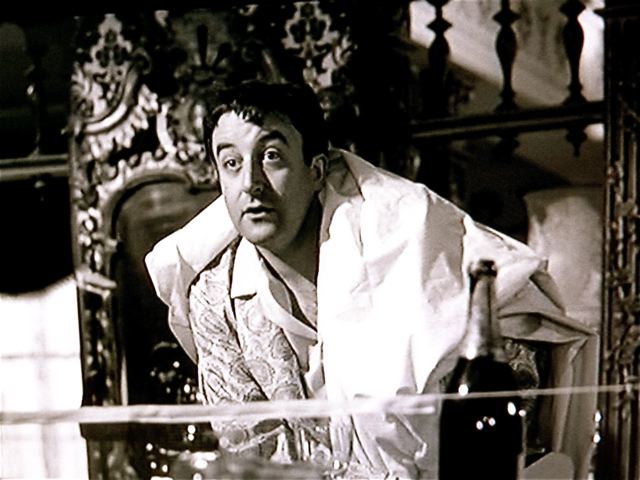
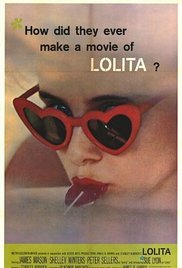 Nabokov adapted his own book for the movie, which blows my mind, cause that means he willingly lived inside these people’s heads twice. Humbert Humbert (James Mason), a visiting English academic, looking just inside his 50s, falls hard for the nymphet Lolita and seals his passion with abduction, paranoia, murder, and a statutory reading of Poe. Sellers is Clare Quilty, a faux-suave gargoyle of the world who puts on plays at Lolita’s school, fabricates identities to steal her from Humbert, and whose every lazy-eyed response sounds filtered through the Ronco Double Entendre 3000. Example: when young Lolita’s upwardly nubile mom (Shelley Winters) mentions to him that the girl “will be getting a cavity filled soon,” Quilty’s gleeful, sidelong “yes…yes” tells you all you need to know about how much Sellers and director Stanley Kubrick relished besting the censors. Quilty generates even more id-engorging repugnance than the main character, but maybe his uber-creepiness is the point, as it provides us a handy pedophile ranking system: Humbert may be depraved, but at least he didn’t ask the girl to appear in his “art” movie.
Nabokov adapted his own book for the movie, which blows my mind, cause that means he willingly lived inside these people’s heads twice. Humbert Humbert (James Mason), a visiting English academic, looking just inside his 50s, falls hard for the nymphet Lolita and seals his passion with abduction, paranoia, murder, and a statutory reading of Poe. Sellers is Clare Quilty, a faux-suave gargoyle of the world who puts on plays at Lolita’s school, fabricates identities to steal her from Humbert, and whose every lazy-eyed response sounds filtered through the Ronco Double Entendre 3000. Example: when young Lolita’s upwardly nubile mom (Shelley Winters) mentions to him that the girl “will be getting a cavity filled soon,” Quilty’s gleeful, sidelong “yes…yes” tells you all you need to know about how much Sellers and director Stanley Kubrick relished besting the censors. Quilty generates even more id-engorging repugnance than the main character, but maybe his uber-creepiness is the point, as it provides us a handy pedophile ranking system: Humbert may be depraved, but at least he didn’t ask the girl to appear in his “art” movie.
The revulsion I felt for Humbert is different than the revulsion I felt for Quilty, and I think it’s born from the difference between Mason’s elegantly modulated comic performance and Sellers’ kooky free-form: watching Humbert’s sad, groping hunger mostly triggers my curiosity over just why Kubrick needed to make this movie at all, but watching Quilty’s disguised bids on behalf of his undisguised lust triggers my enjoyment in watching a great comic actor burrow so deep into what are really just glorified bits, that ultimately they float somewhere above the meaning of the movie. Sellers’ odyssey from urbane degenerate to sniveling proto-Ratso Rizzo to German proto-Strangelove became the only thing keeping me going through much of the last third of the movie.
While it’s having fun propping Humbert’s depraved libidinous pursuit up against the iconic mid-century Americana of hula hoops and drive-ins, Lolita the movie never seems to me to find its point. Minus the book’s framing device – memoire of self-aware pervert presented by psychologist who at least positions (though doesn’t justify) Humbert’s passion as unrequited pubescent love – we’re left with just a man who suddenly falls for a young girl and never recovers. The movie trades that framing device for its own deeply suspense-draining one, showing Humbert killing Quilty amongst the scattered remnants of his gutted neoclassical mansion in the first ten minutes, then flashing back to what got us there. Thus we learn why the murder is necessary, but never why the movie is.
Frankly, I would’ve been happy if every other scene was just Humbert laugh-reading mom’s get-out-of-the-house-before-I’m-home letter – I’ve never seen such believable extended laughing onscreen, or condescension. Then the rest of the movie could be Sellers as the motor-mouthed policeman, just to see how long he could carry it.
Dr. Strangelove Or: How I Learned To Stop Worrying And Love The Bomb
(1964, Columbia Pictures, Dir. Stanley Kubrick)
by Krystal Lyon
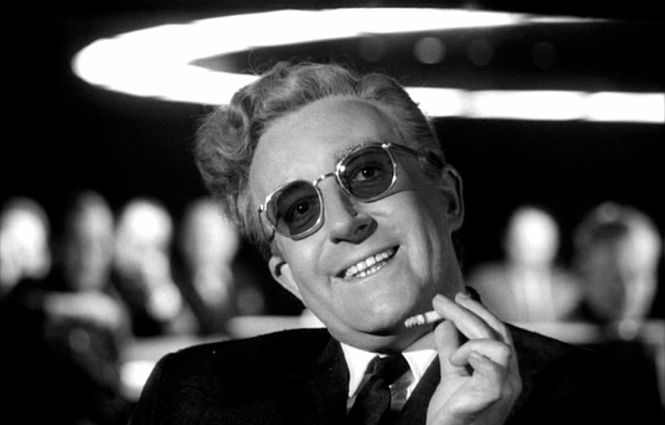
 Peter Sellers in three roles! Three distinct roles, and originally Kubrick wanted him to play a fourth. According to Kubrick, “everywhere you turn there is some version of Peter Sellers holding the fate of the world in his hands.” In Dr. Strangelove, Sellers plays a buffoon president, a maniacal ex-Nazi scientist, and a calm RAF captain, we see the radius of his genius. And here’s the thing, I have around 400 words to convey to you the satire and dark humor, the beautiful cinematography and style, the humor, the relevance and the brilliance of George C. Scott and Slim Pickens in this film. It’s totally impossible! So I’m going to focus on the man Peter Sellers, his lines, his delivery and how very few could pull off such a performance.
Peter Sellers in three roles! Three distinct roles, and originally Kubrick wanted him to play a fourth. According to Kubrick, “everywhere you turn there is some version of Peter Sellers holding the fate of the world in his hands.” In Dr. Strangelove, Sellers plays a buffoon president, a maniacal ex-Nazi scientist, and a calm RAF captain, we see the radius of his genius. And here’s the thing, I have around 400 words to convey to you the satire and dark humor, the beautiful cinematography and style, the humor, the relevance and the brilliance of George C. Scott and Slim Pickens in this film. It’s totally impossible! So I’m going to focus on the man Peter Sellers, his lines, his delivery and how very few could pull off such a performance.
Before I tell you which performance of Sellers is my favorite, lets compare him to others who have played multiple roles in a film. John Cleese and the entire cast of Monty Python and The Holy Grail, Eddie Murphy in The Nutty Professor, and more recently every major actor in Cloud Atlas. There are plenty of examples, this was not a singular idea for Kubrick. But here’s the kicker, and maybe it’s just me, but I didn’t recognize Sellers as President Merkin Muffley right away. Sellers makes you forget that he is just one guy. You leave Dr. Strangelove knowing three very different characters. That is his genius! He was a master of disguise and of voices, and his comic timing is perfection. I only wish he hadn’t twisted his ankle and he could have taken on that fourth role as Major “King” Kong, a Texan pilot that physically drops the bomb.
While Sellers roles in Dr. Strangelove are placed in 1st, 2nd and 3rd in my mind, there is not a weak one. All three characters make me laugh. RAF Captain Lionel Mandrake comes in third. Mandrake’s timid demeanor is the perfect complement to the firm and peculiar General Jack D. Ripper. And his banter with Col. ‘Bat’ Guano over change from a Coca-Cola machine and calling the President collect is slapstick perfection. PS… Kubrick’s name choices are impeccable. Coming in second is Dr. Strangelove himself. Sellers stole one of Kubrick’s gloves he wore to change light bulbs because he thought it made him look menacing. The character, Dr. Strangelove, is a nod to every mad scientist in film but specifically Sellers studied Fritz Lang’s classic Metropolis and copied Rudolf Klein-Rogge’s Rotwang. The Doctor’s Alien Hand Syndrome and Nazi background make him the wild card, the total eccentric. Again Sellers gets lost in the role. You forget that this is the same man that is talking calmly with Ripper about bodily fluids and fluoridation in the previous scene. Which leaves us with President Merkin Muffley. He is first in my heart because every line he delivered made me laugh. His phone call alone to Dimitri Kissoff makes the movie worth watching. (Again Kubrick’s name choices are solid gold!) Imagine the jab that Kubrick is having at politics with the following phone conversation. “I’m sorry too, Dmitri. I’m very sorry. All right, you’re sorrier than I am. But I am sorry as well. I am as sorry as you are, Dmitri. Don’t say that you’re the more sorry than I am because I am capable of being just as sorry as you are. So we’re both sorry, all right? All right.” And then imagine Sellers delivering those lines as if he is a middle-aged housewife talking on the phone with a friend. This is satire and comedy at their finest. And while Kubrick was the mastermind in pulling all the pieces together, it’s the details in the characters that Sellers adds that make the movie a total classic. I’m just “very sorry” that I’m just now crossing it off my list.
The Ladykillers
(1955, Ealing Studios, dir. Alexander Mackendrick)
by Sharon Autenrieth
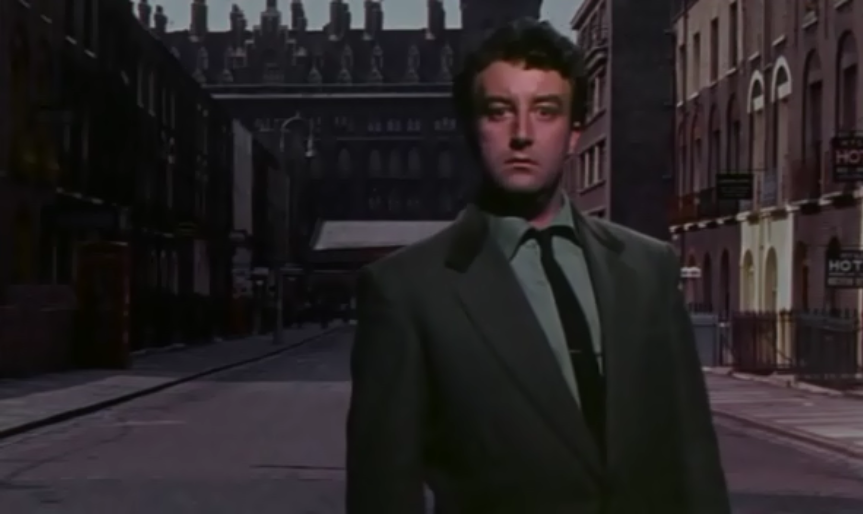
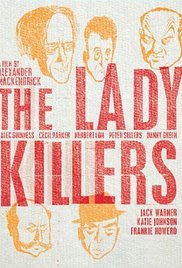 From the mid-40s the mid-50s, the Ealing Studio released a series of comedies (many starring Alec Guinness) that were acidic, bleak and ruthless. They are so very quintessentially British that I often forget how subversive and cold-blooded the movies actually were. The Ladykillers (1955) came near the end of this run of films, and finds Alec Guinness as the bucktoothed head of a band of criminals. Under the guise of a string quartet they board in the home of an elderly widow, Mrs. Wilberforce (Katie Johnson), and plan to carry out a heist at nearby King’s Cross Station. Mrs. Wilberforce, apple cheeked and with a high, girlish voice, turns out to be a formidable obstacle to this scheme – although almost unwittingly. She means only to be kind and helpful, but disaster and disruption follow in her wake. To quote C.S. Lewis, “She’s the sort of woman who lives for others – you can tell the others by their hunted expression.”
From the mid-40s the mid-50s, the Ealing Studio released a series of comedies (many starring Alec Guinness) that were acidic, bleak and ruthless. They are so very quintessentially British that I often forget how subversive and cold-blooded the movies actually were. The Ladykillers (1955) came near the end of this run of films, and finds Alec Guinness as the bucktoothed head of a band of criminals. Under the guise of a string quartet they board in the home of an elderly widow, Mrs. Wilberforce (Katie Johnson), and plan to carry out a heist at nearby King’s Cross Station. Mrs. Wilberforce, apple cheeked and with a high, girlish voice, turns out to be a formidable obstacle to this scheme – although almost unwittingly. She means only to be kind and helpful, but disaster and disruption follow in her wake. To quote C.S. Lewis, “She’s the sort of woman who lives for others – you can tell the others by their hunted expression.”
One of the criminals is Harry (Peter Sellers); a slick operator in flashy suits. This was early in Seller’s career and unfortunately for this collaborative piece, the role – and Sellers – are forgettable. It’s a fine movie: Katie Johnson is wonderful as Mrs. Wilberforce and the other criminals are distinct characters. I especially enjoyed Danny Green as “One Round”, the giant, slow witted mook who is far too soft hearted to consider murder. But Harry is another matter: he would sink right into the wallpaper if not for his attire. It’s a reminder that Sellers could transform himself entirely in roles like Inspector Clouseau, or even in multiple roles in the same film (as in Dr. Strangelove: Or, How I Stopped Worrying and Learned to Love the Bomb). But in an unadorned performance he was strangely blank. It’s why he’s so effective as Chance the gardener in Being There; because he can become anything people perceive him to be – or nothing at all. Unfortunately, in The Ladykillers, Peter Sellers is closer to nothing in an otherwise scene-stealing cast.
Being There
(1979, BSB, dir. Hal Ashby)
by Erik Yates
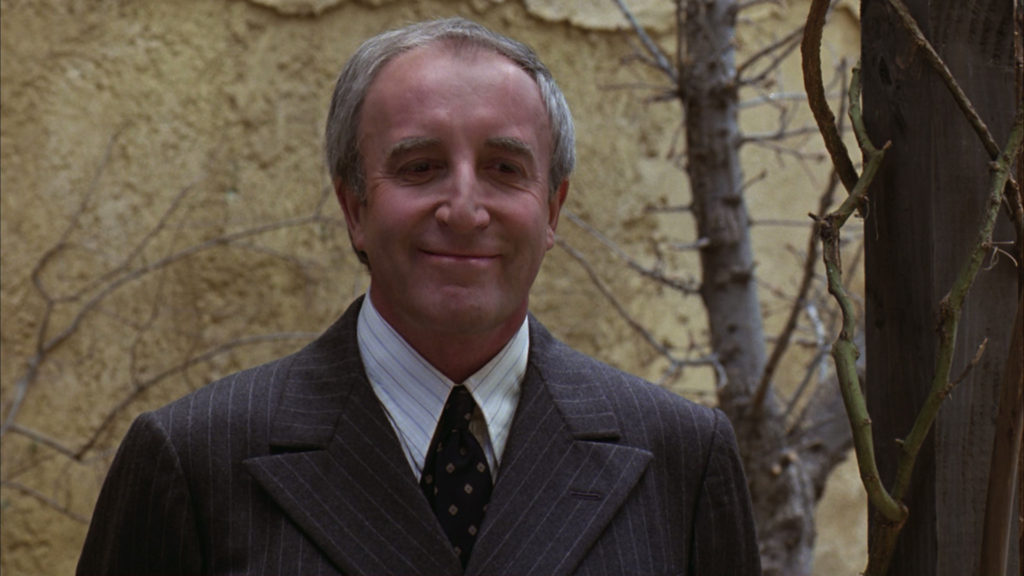
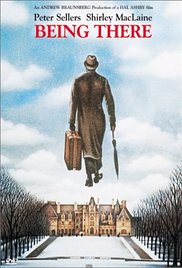 I’m ashamed to say that I have never seen Peter Sellers’ wonderful Being There until now. Seller’s final film released before his death, it is a wonderfully rich and layered performance that earned him an Oscar nomination. This film deserves its own review for me to properly discuss so many themes that are swirling around the very simple-minded character of Chance the Gardner, but a few thoughts will have to suffice.
I’m ashamed to say that I have never seen Peter Sellers’ wonderful Being There until now. Seller’s final film released before his death, it is a wonderfully rich and layered performance that earned him an Oscar nomination. This film deserves its own review for me to properly discuss so many themes that are swirling around the very simple-minded character of Chance the Gardner, but a few thoughts will have to suffice.
Despite being filmed in 1979, the film is still very contemporary on a few fronts. One is the way that Chance is a man of the modern age, watching the newest media form of television, and forsaking the old – namely, newspapers. Sure, this is because he can’t read, but it is also such a contrast with the idea that while he embraces television, he still is a man of an earlier time. People are confounded that they can find nothing about this man who emerges out of nowhere. Newspapers, the F.B.I. and C.I.A. are all confounded that they can’t find out anything about this man…much like someone today would be if they couldn’t dig up any information about someone by “google-ing” them or scanning countless social media websites. He continues to simply walk through life with the purest intentions unaware of the tempest swirling around him because he cannot be “figured out” or owned.
The film is a great satire on politics and media, but has much to say about race relations that is still a relevant conversation in light of Baltimore, and Ferguson, #BlackLivesMatter, and the death of police officers in Texas, Illinois, and elsewhere. The final shot of the film also has continued to evoke debate upon its meaning with some talking about a messianic interpretation of Chance’s simple way contrasting with how muddled the rest of society seems to be. I think that as the final words “life is a state of mind” are uttered by a character off-screen, we see Sellers walk on water, letting us know that those who are pure of heart and not tainted in their intentions will find themselves doing the impossible. This is the kind of person that impacts others, not the powerful, nor the media, wealth, etc. Sellers’ career is perfectly concluded with this extremely understated tour de force that is an extreme contrast with his characters like Chief Inspector Jacques Clouseau, or his multiple characters in Dr. Strangelove and The Mouse that Roared. Sellers’ comedic legacy continues to endure because the material and medium he used continues to provoke, challenge, entertain and makes us laugh today.
I Love You, Alice B. Toklas!
(1968, Warner Brothers/Seven Arts, dir. Hy Averback)
by Jim Tudor
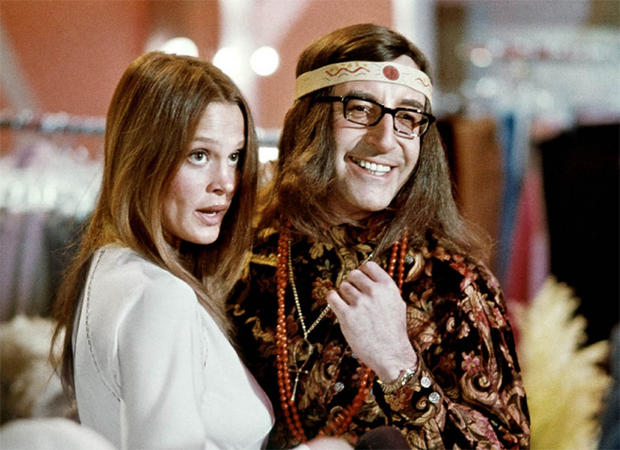
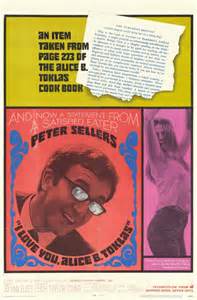 Sometime following his acclaimed success in 1964’s Dr. Strangelove, Peter Sellers is said to have stopped caring as much about his career. The result is a grey period spanning from the mid-1960s and through the 1970s, a span with arguably not one truly great film among his output (although Vittorio De Sica’s After the Fox is a riot) . It wouldn’t be until his swan song in Hal Ashby’s masterpiece Being There that Sellers would once more, at long last, find himself. The inbetween time would amass amusing if unecessary Pink Panther sequels and largely forgotten cultural relics as Sellers, so universally lauded for his undeniable talent, toiled away on screen.
Sometime following his acclaimed success in 1964’s Dr. Strangelove, Peter Sellers is said to have stopped caring as much about his career. The result is a grey period spanning from the mid-1960s and through the 1970s, a span with arguably not one truly great film among his output (although Vittorio De Sica’s After the Fox is a riot) . It wouldn’t be until his swan song in Hal Ashby’s masterpiece Being There that Sellers would once more, at long last, find himself. The inbetween time would amass amusing if unecessary Pink Panther sequels and largely forgotten cultural relics as Sellers, so universally lauded for his undeniable talent, toiled away on screen.
Indicative of this era is 1968’s I Love You, Alice B. Toklas!, a fish-out-of-water chuckler that trades on the rising hippie culture of the day. Sellers plays Harold Fine, a suit-wearing stooge as bland as his name. Harold, a tightly wound man (or as the hippies say, “uptight”) who’s terminally afraid of commitment, is being presured by both his girlfriend and his domineering mother to get married. He crashed his car, and is made to temporarily drive the mechanic’s son’s psychodelic hippie-mobile. Harold reconnects with his hippie brother, and ends up taken with his girlfriend, Nancy (Leigh Taylor-Young, who was somehow Golden Globe nominated for this), a flighty mini-dress wearing tart who’s marijuana brownies are the hit of his family and friends. The recipe was first published by Gertrude Stein’s lover Alice B. Tolkas, hence the odd title.
The sight of the “uptights” in Harold’s life getting unknowingly baked is the film’s idea of counter-culture-baiting comedy. Eventually, Harold goes full on hippie – long hair, free love, beads, the works. But director Hy Averback, said to have clashed bitterly with the difficult Sellers in the making of this piffle, can’t ever quite manage to score any real laughs. The film is not poor, but it is terminally of its time and place. Aside from Sellers inconequentially playing the lead, the only other noteworthy aspect of Toklas is the fact that the screenplay was co-written by Paul Mazursky, who would launch well into his own marked directorial career the following year with Bob & Carol & Ted & Alice. At times, it’s difficult to peg whether the film is onboard with the counter culture it so adorns, or mocking it. I suppose it doesn’t matter. This is just Sellers trying to find himself; a sentiment echoed by his character in the movie. All in all, I Love You, Alice B. Toklas! is a trip worth taking only for Sellers and groovy-movie completists.

